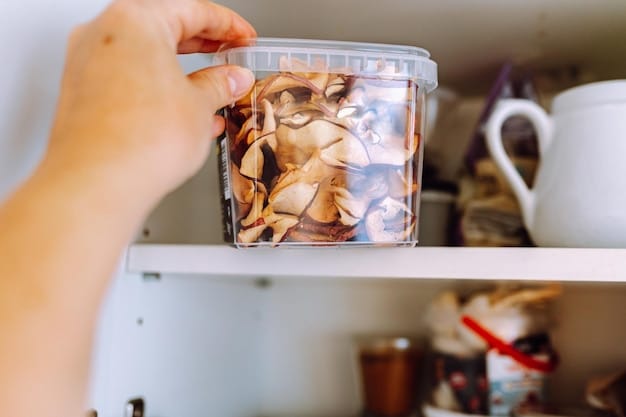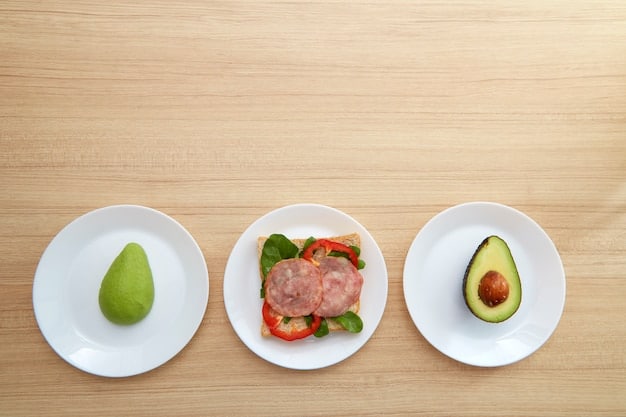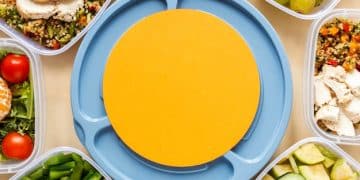Avoid These 5 Meal Planning Mistakes to Save Money Now

Discover the 5 common meal planning mistakes that might be costing you money and learn how to fix them effectively. By avoiding these errors and implementing smart strategies, you can optimize your meal plans, reduce food waste, and achieve significant savings.
Are you diligently planning your meals, only to find your grocery bills are still sky-high? You might be making some common, yet costly, mistakes. Let’s dive into 5 common meal planning mistakes that are costing you money (and how to fix them), ensuring you get the most out of your budget and your food.
Ignoring Your Current Inventory
One of the first steps in efficient meal planning is often overlooked: checking what you already have. Many people start planning meals from scratch without considering the food already in their pantry, refrigerator, and freezer. This leads to unnecessary purchases and food waste, directly impacting your budget.
Failing to inventory your existing food supplies can lead to buying duplicates, letting perfectly good ingredients expire, and hindering creative meal ideas using what you have on hand. It’s a simple step that can make a big difference.
How to Fix It
The solution is straightforward: before you even think about planning your meals, conduct a thorough inventory check. Make it a habit to review your pantry and refrigerator at least once a week. This way, you will avoid overbuying and focus on utilizing what you already possess.
- Create a Master Inventory List: Keep a running list of staples in your pantry and frequently used items in your fridge. This allows you to quickly reference what you have and what you need.
- “Eat Me First” Shelf: Designate a specific area in your fridge or pantry for items that are nearing their expiration dates. This simple visual reminder can help you prioritize those ingredients in your meal planning.
- Use Inventory Apps: Multiple apps are available to help you keep track of your food inventory, set expiration reminders, and even suggest recipes based on what you have on hand.
By regularly tracking your inventory, you will reduce food waste, save money by only buying what you need, and get creative with meals using ingredients you might otherwise have forgotten about.

Not Building a Flexible Plan
Rigid meal plans often flop because life gets in the way. Sticking to a strict schedule of meals without accounting for unexpected events, changes in your schedule, or simply not feeling like eating what you planned can lead to wasted food and money.
A meal plan that doesn’t allow for flexibility is doomed to fail, leading to more take-out orders and more food ending up in the trash. The key is to create a plan that can adapt to the ebb and flow of daily life.
Incorporating Flexibility
Building a flexible plan involves several strategies that allow you to adjust your meals as needed without letting food go to waste.
- Schedule “Flex Nights”: Plan one or two nights a week where you don’t have a specific meal in mind. This allows you to use up leftovers, try new recipes spontaneously, or order takeout if you’re simply too tired to cook.
- Prepare Versatile Ingredients: Cook large batches of versatile ingredients, such as grilled chicken, rice, or roasted vegetables. These ingredients can be used in multiple meals throughout the week, reducing cooking time and ensuring that food doesn’t go to waste.
- Have Backup Options: Keep a list of quick and easy meals that you can prepare with minimal effort and ingredients. This can be a lifesaver when unexpected events disrupt your meal planning schedule.
By creating a meal plan with flexibility, you can reduce food waste, save money on last-minute takeout orders, and enjoy the process of meal planning rather than feeling restricted by it.
Failing to Check Weekly Ads and Sales
One of the easiest ways to save money on groceries is by taking advantage of weekly ads and sales. Many people plan their meals without considering what’s on sale, which can lead to paying full price for items that could be significantly cheaper.
Ignoring weekly ads and sales means missing out on significant savings opportunities and potentially overspending on ingredients. Actively looking for discounts and sales can dramatically reduce your overall grocery bill.
Leveraging Weekly Ads
To make the most of weekly ads, integrate them into your meal planning process.
- Review Ads Before Planning: Before you start planning your meals for the week, take a look at the weekly ads from your local grocery stores. This will give you an idea of what’s on sale and help you plan meals around those discounted items.
- Plan Around Seasonal Produce: Seasonal produce is often heavily discounted when it’s in season. Plan your meals around fruits and vegetables that are currently in season to save money and enjoy the freshest possible ingredients.
- Stock Up on Sale Items: If there’s a non-perishable item that you use frequently and it’s on sale, consider stocking up. This can save you money in the long run and ensure that you always have essential ingredients on hand.
By incorporating weekly ads and sales into your meal planning, you can cut costs, enjoy seasonal produce, and maximize your grocery budget.
Overlooking Portion Sizes
Accurate portioning is a cornerstone of successful meal planning. Many individuals misjudge how much food they need for each meal, leading to either overeating or excess leftovers that often go to waste. This oversight can quickly translate into wasted money.
Consistently overlooking portion sizes doesn’t just affect your waistline; it also empties your wallet faster. Preparing too much food that ends up uneaten becomes a recurring drain on both your financial resources and environmental responsibilities.

Optimize Your Portions
To mitigate this, it’s crucial to reassess and refine your portion sizes, aligning them with your dietary needs and reducing excess food. There are several effective methods to help you achieve this:
- Use Smaller Plates: Opting for smaller plates and bowls can psychologically trick your mind into feeling more satisfied with less food.
- Pre-Portion Meals: Setting aside individual serving sizes when you prepare your meals simplifies portion control. Pack each meal into separate containers to further regulate how much you consume at each sitting.
- Pay Attention to Nutritional Labels: Get familiar with the recommended serving sizes for various foods by carefully reading nutritional labels, ensuring you don’t over-consume and can better manage portioning.
Adopting these simple practices ensures optimized portion control, thereby minimizing food waste, managing your budget effectively, and promoting healthier eating habits that align with your body’s needs.
Neglecting to Track Spending and Waste
A critical oversight in meal planning is failing to monitor both your spending and the amount of food wasted. Many individuals plan meals without having a system to track how much they spend on groceries or how much food they end up throwing away, which hinders their ability to make informed adjustments.
Without tracking mechanisms, it’s difficult to understand where you can improve. Neglecting spending tracking and waste management impedes identifying problematic areas in your meal planning strategy, impeding potential savings and preventing inefficiencies.
Implement Tracking Systems
Adopting systems to monitor spending and waste is imperative for enhancing the effectiveness of meal planning. Here’s how you can get started:
- Use Budgeting Apps: Utilize apps designed to track expenses to oversee your grocery spending. Most budget apps allow you to categorize purchases, giving you a clear view of how much you’re allocating to each category, including food.
- Keep a Food Waste Log: Maintain a log for tracking expiration and discarded leftovers. This exercise brings awareness to your consumption habits and allows you to discover foods often wasted, helping you to avoid buying them in the future.
- Review Expenses Regularly: Regularly review your grocery expenses and waste log each month to identify spending and waste patterns. Adjust your meal plans accordingly, reducing recurring problems and making informed decisions.
By integrating tracking tools, you gain insights to refine your meal prepping tactics, curtail wasteful habits, and more effectively manage your household finances, resulting in continuous savings.
| Key Point | Brief Description |
|---|---|
| 📝 Inventory First | Always check your pantry before planning meals to avoid duplicates and reduce waste. |
| 🗓️ Flexible Plans | Include “flex nights” and versatile ingredients for adaptable, less wasteful meals. |
| 🛒 Weekly Ads | Plan meals around weekly ads and seasonal produce to maximize savings. |
| 🥗 Portion Control | Use smaller plates and pre-portion meals to prevent overeating and reduce leftovers. |
Frequently Asked Questions (FAQ)
▼
Ideally, meal planning should be done weekly. This regularity allows for flexibility and adjustments based on your schedule and available ingredients, ensuring minimal waste and maximum savings.
▼
Several apps and websites offer meal planning templates, recipe suggestions, and grocery list features. These tools can streamline the planning process and make it more efficient and enjoyable.
▼
Prioritize whole foods, lean proteins, and plenty of fruits and vegetables in your meal plan. Consult with a nutritionist for personalized advice tailored to your dietary needs.
▼
Substitute refined grains with whole grains, replace sugary drinks with water, and use healthier cooking oils like olive or avocado oil for lighter, more nutritious meals.
▼
Yes, meal prepping significantly reduces food waste because you only buy what you need for the week, and ensures leftovers are consumed or repurposed effectively, minimizing waste.
Conclusion
Avoiding these meal planning mistakes can lead to significant savings and a more sustainable approach to food consumption. By implementing flexible plans, tracking spending, and utilizing what you already have, you can optimize your grocery budget and reduce food waste effectively.





